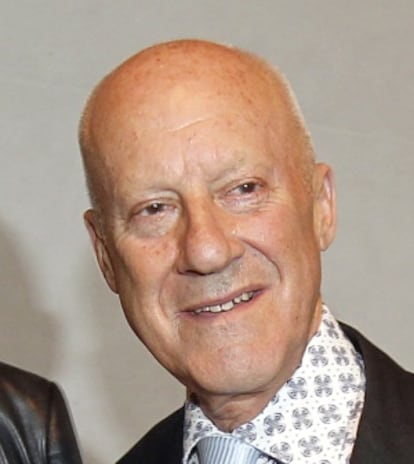Norman Foster drops plans to create his foundation in Madrid
Heritage committee vetoes architect’s proposals to alter historic mansion

Norman Foster has canceled plans to establish the headquarters of his foundation – which was to be dedicated to architecture, urban planning, art and design, as well as hosting his sizeable personal archive – in Madrid.
The British architect had purchased an historic mansion in the capital’s central Chamberí district for the purpose of the project and created an urban plan to allow him to remodel it as he wanted.
Madrid City Hall approved Foster’s plans, but, as the building is listed as protected, he still had to send them to the public committee responsible for preserving the city’s cultural heritage. Upon doing so, he added a series of changes to the approved plan. The committee accepted the project, but rejected some of those changes.
Foster’s office declined to reveal whether the foundation would now be set up elsewhere
Foster informed City Hall of his intention to cancel the project a short while after learning of the decision, EL PAÍS has learned. His office cited personal reasons, but declined to give further explanations or reveal whether the foundation would now be set up elsewhere – in Spain or abroad – or be shelved for good.
One of the world’s most influential architects, Foster has a studio in Madrid, and also designed the Torre Bankia, one of the Cuatro Torres skyscrapers situated at the northern end of the capital’s long Paseo de la Castellana boulevard. He has been married to the Spanish gallery owner and publisher Elena Ochoa since 1996.

The 1999 Pritzker Architecture Prize winner bought the mansion, situated at 48 Monte Esquinza street, from Spanish bank Bankia last spring for just over €9 million. Built by architect Joaquín Saldaña in 1902 as the residence of the Duke of Plasencia, it later became an embassy and finally the headquarters of Altae Banco, which became part of Bankia in 2011 and subsequently moved offices.
Foster registered a foundation bearing his name and headquartered in London in 1999. His plan had been to open a center in Madrid in the next few months that went beyond its status as a museum and archive, turning its exhibitions, debates and publications into the main attraction. It was also set to house a permanent display of the models, drawings, plans and films he created for his many buildings around the world, as well as a selection from his and his wife’s art collection. A café, terrace and bookstore were also planned.
Madrid City Hall was not set to contribute funds to the project, but did approve the plans drawn up for it last November. It also promoted it as an essential attraction for reactivating tourism and the local economy. “We are managing strategic operations such as the establishment of the Foster Foundation,” said Mayor Ana Botella of the Popular Party last year.
The center was set to house a permanent display of his models, drawings, plans and films for his many buildings
But according to City Hall sources, the foundation sent the local heritage committee a proposal containing several changes that were incompatible with the urban plan that it itself had drawn up as they endangered the protection of the building as a whole.
The sources added that the final report was generally positive, with a series of limitations, some of which were open to reevaluation.
Nevertheless, the architect has now sent a letter to municipal authorities informing them of the suspension of the project in order “to decide on the suitability of the location,” which they fear is definitive.
Tu suscripción se está usando en otro dispositivo
¿Quieres añadir otro usuario a tu suscripción?
Si continúas leyendo en este dispositivo, no se podrá leer en el otro.
FlechaTu suscripción se está usando en otro dispositivo y solo puedes acceder a EL PAÍS desde un dispositivo a la vez.
Si quieres compartir tu cuenta, cambia tu suscripción a la modalidad Premium, así podrás añadir otro usuario. Cada uno accederá con su propia cuenta de email, lo que os permitirá personalizar vuestra experiencia en EL PAÍS.
¿Tienes una suscripción de empresa? Accede aquí para contratar más cuentas.
En el caso de no saber quién está usando tu cuenta, te recomendamos cambiar tu contraseña aquí.
Si decides continuar compartiendo tu cuenta, este mensaje se mostrará en tu dispositivo y en el de la otra persona que está usando tu cuenta de forma indefinida, afectando a tu experiencia de lectura. Puedes consultar aquí los términos y condiciones de la suscripción digital.
Últimas noticias
The complicated life of Francesca Albanese: A rising figure in Italy but barred from every bank by Trump’s sanctions
Half of Scotland is in the hands of 420 property owners
Pinochet’s victims grapple with José Antonio Kast’s rise in Chile
Reinhard Genzel, Nobel laureate in physics: ‘One-minute videos will never give you the truth’
Most viewed
- Pablo Escobar’s hippos: A serious environmental problem, 40 years on
- Why we lost the habit of sleeping in two segments and how that changed our sense of time
- Charles Dubouloz, mountaineering star, retires at 36 with a farewell tour inspired by Walter Bonatti
- Reinhard Genzel, Nobel laureate in physics: ‘One-minute videos will never give you the truth’
- The Florida Keys tourist paradise is besieged by immigration agents: ‘We’ve never seen anything like this’








































